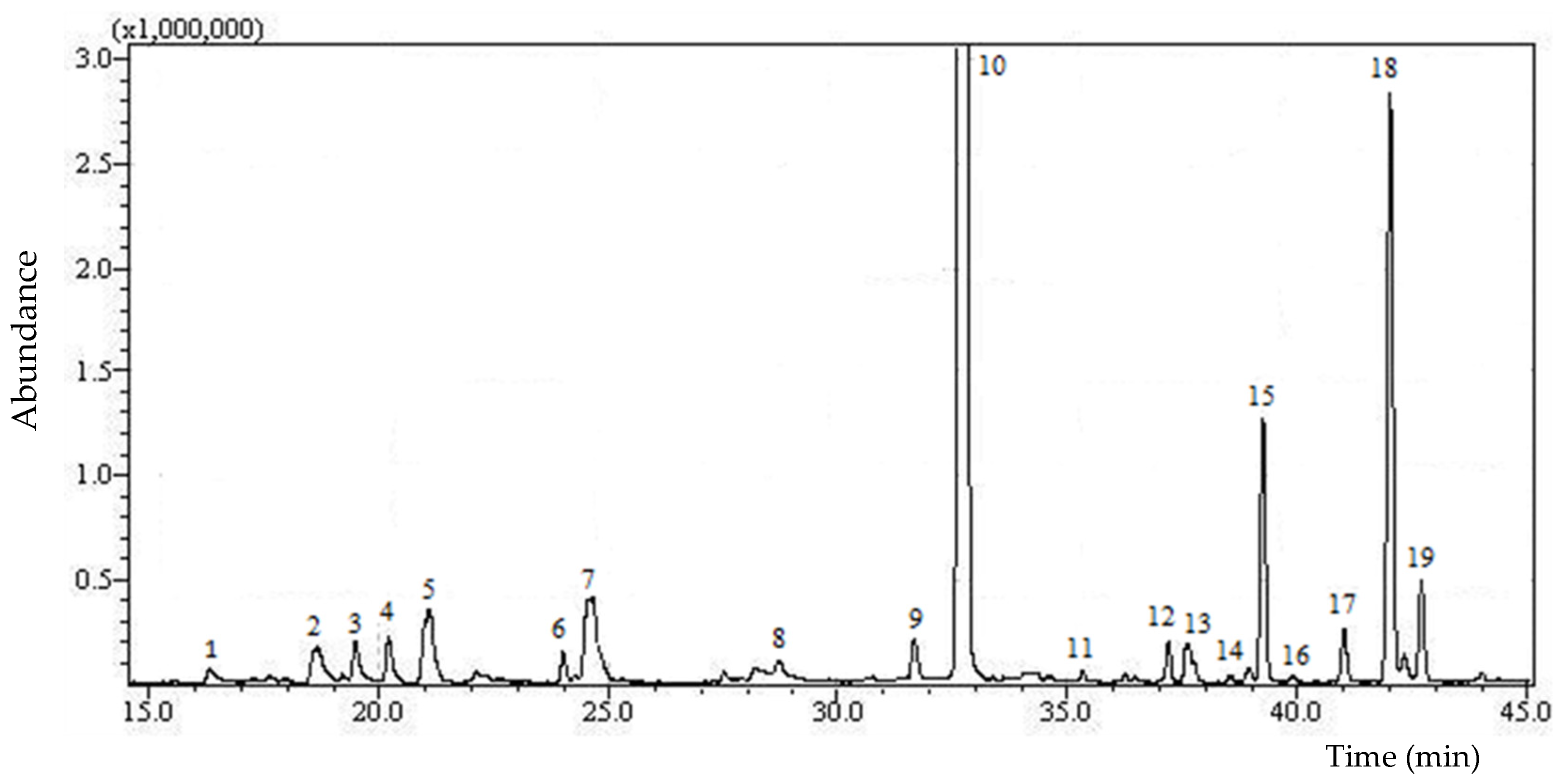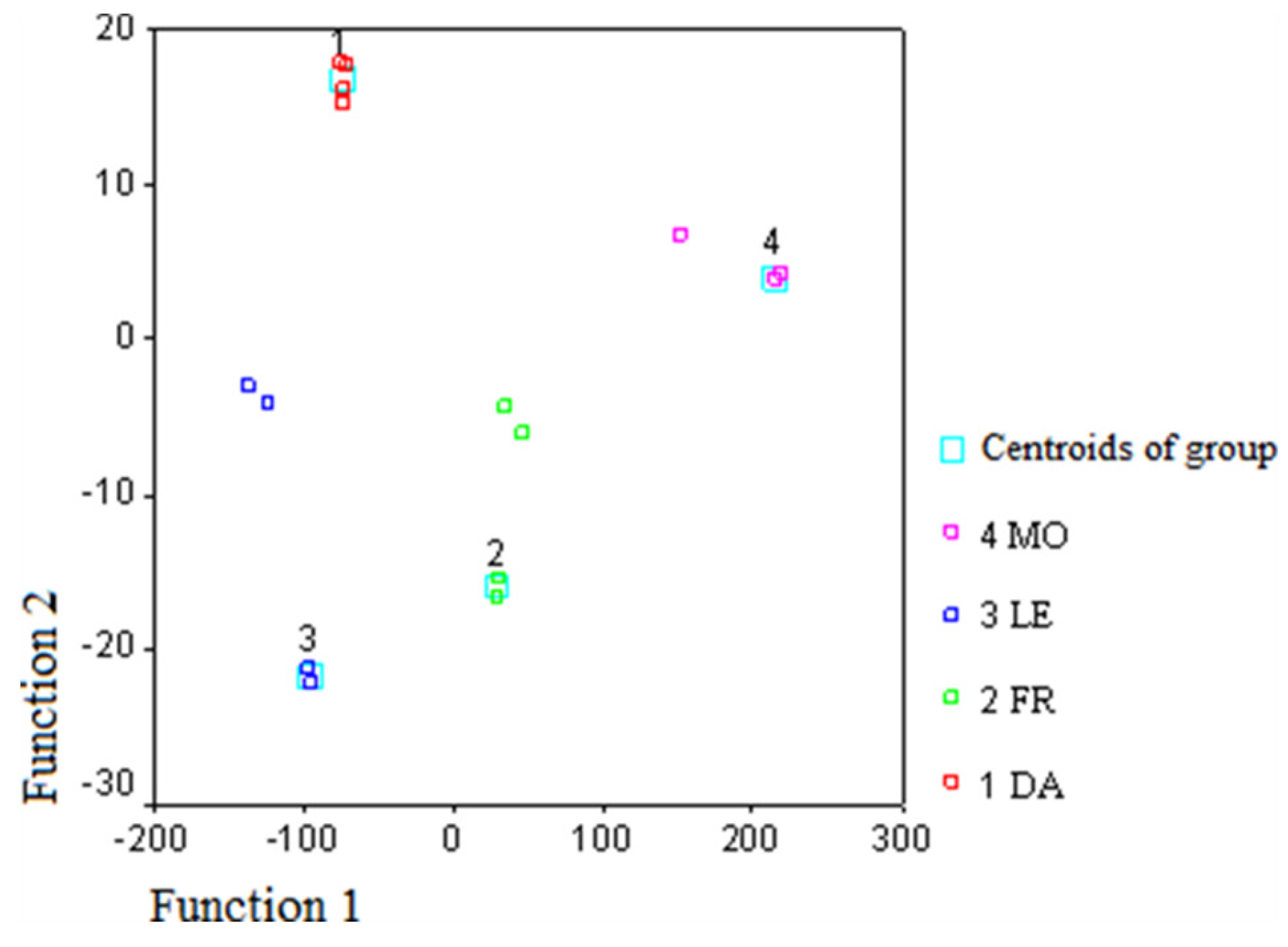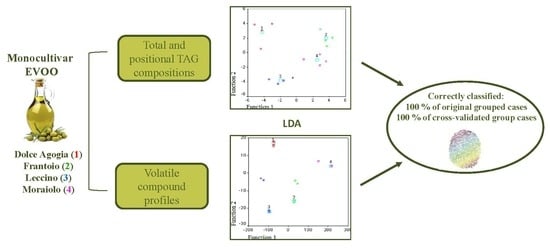Varietal Authentication of Extra Virgin Olive Oils by Triacylglycerols and Volatiles Analysis
Abstract
:1. Introduction
2. Materials and Methods
2.1. Materials and Chemicals
2.2. EVOO Samples
2.3. Purification of TAG Fraction from EVOO Samples
2.4. Stereospecific Analysis of TAG Fraction from EVOO Samples
2.5. Preparation of Methyl Esters of Constituent Fatty Acids and Analysis
2.6. Analysis of Volatile Fraction
2.7. Statistical Analysis
3. Results and Discussion
3.1. Triacylglycerol Fraction
3.2. Volatile Fraction
3.3. Discriminant Analysis
4. Conclusions
Author Contributions
Funding
Acknowledgments
Conflicts of Interest
References
- Serra-Majem, L.; Ortiz-Andrellucchi, A.; Sánchez-Villegas, A. Mediterranean diet. In Encyclopedia of Food Security and Sustainability; Ferranti, P., Berry, E.M., Anderson, J.R., Eds.; Elsevier: New York, NY, USA, 2019; pp. 292–301. [Google Scholar]
- Giacometti, J.; Milin, C.; Giacometti, F.; Cigan, Z. Characterisation of monovarietal olive oils obtained from croatian cvs. Drobnica and Buza during the ripening period. Foods 2018, 7, 188. [Google Scholar] [CrossRef] [PubMed]
- Aparicio, R.; Luna, G. Characterisation of monovarietal virgin olive oils. Eur. J. Lipid Sci. Technol. 2002, 104, 614–627. [Google Scholar] [CrossRef]
- Martins-Lopes, P.; Gomes, S.; Pereira, L.; Guedes-Pinto, H. Markers for food traceability. Food Technol. Biotechnol. 2013, 51, 198–207. [Google Scholar]
- Bertoldi, D.; Cossignani, L.; Blasi, F.; Perini, M.; Barbero, A.; Pianezze, S.; Montesano, D. Characterisation and geographical traceability of Italian goji berries. Food Chem. 2019, 275, 585–593. [Google Scholar] [CrossRef] [PubMed]
- Fuentes, E.; Paucar, F.; Tapia, F.; Ortiz, J.; Jimenez, P.; Romero, N. Effect of the composition of extra virgin olive oils on the differentiation and antioxidant capacities of twelve monovarietals. Food Chem. 2018, 243, 285–294. [Google Scholar] [CrossRef]
- Jiménez-Carvelo, A.M.; Cruz, C.M.; Olivieri, A.C.; González-Casado, A.; Cuadros-Rodríguez, L. Classification of olive oils according to their cultivars based on second-order data using LC-DAD. Talanta 2019, 195, 69–76. [Google Scholar] [CrossRef]
- Portarena, S.; Anselmi, C.; Zadra, C.; Farinelli, D.; Famiani, F.; Baldacchini, C.; Brugnoli, B. Cultivar discrimination, fatty acid profile and carotenoid characterization of monovarietal olive oils by Raman spectroscopy at a single glance. Food Control 2019, 96, 137–145. [Google Scholar] [CrossRef]
- Alonso-Rebollo, A.; Ramos-Gómez, S.; Busto, M.D.; Ortega, N. Development and optimization of an efficient qPCR system for olive authentication in edible oils. Food Chem. 2017, 232, 827–835. [Google Scholar] [CrossRef]
- Dias, L.G.; Rodrigues, N.; Veloso, A.C.A.; Pereira, J.A.; Peres, A.M. Monovarietal extra-virgin olive oil classification: A fusion of human sensory attributes and an electronic tongue. Eur. Food Res. Technol. 2016, 242, 259–270. [Google Scholar] [CrossRef]
- Cossignani, L.; Blasi, F.; Simonetti, M.S.; Montesano, D. Fatty acids and phytosterols to discriminate geographic origin of Lycium barbarum berry. Food Anal. Meth. 2018, 11, 1180–1188. [Google Scholar] [CrossRef]
- de Medina, V.S.; Priego-Capote, F.; Luque de Castro, M.D. Characterization of monovarietal virgin olive oils by phenols profiling. Talanta 2015, 132, 424–432. [Google Scholar] [CrossRef] [PubMed]
- Portarena, S.; Farinelli, D.; Lauteri, M.; Famiani, F.; Esti, M.; Brugnoli, E. Stable isotope and fatty acid compositions of monovarietal olive oils: Implications of ripening stage and climate effects as determinants in traceability studies. Food Control 2015, 57, 129–135. [Google Scholar] [CrossRef]
- Merchak, N.; Rizk, T.; Silvestre, V.; Remauda, G.S.; Bejjani, J.; Akoka, S. Olive oil characterization and classification by 13C NMR with a polarization transfer technique: A comparison with gas chromatography and 1H NMR. Food Chem. 2018, 245, 717–723. [Google Scholar] [CrossRef]
- Gurdeniz, G.; Tokatli, F.; Ozen, B. Differentiation of mixtures of monovarietal olive oils by mid-infrared spectroscopy and chemometrics. Eur. J. Lipid Sci. Technol. 2007, 109, 1194–1202. [Google Scholar] [CrossRef]
- Faberi, A.; Marianella, R.M.; Fuselli, F.; La Mantia, A.; Ciardiello, F.; Montesano, C.; Mascini, M.; Sergi, M.; Compagnone, D. Fatty acid composition and δ13 C of bulk and individual fatty acids as marker for authenticating Italian PDO/PGI extra virgin olive oils by means of isotopic ratio mass spectrometry. J. Mass Spectrom. 2014, 49, 840–849. [Google Scholar] [CrossRef]
- Circi, S.; Ingallina, C.; Vista, S.; Capitani, D.; Di Vecchia, A.; Leonardi, G.; D’Achille, G.; Centauri, L.; Camin, F.; Mannina, L. A multi-methodological protocol to characterize PDO olive oils. Metabolites 2018, 8, 43. [Google Scholar] [CrossRef] [PubMed]
- Lukić, I.; Carlin, S.; Horvata, I.; Vrhovsek, U. Combined targeted and untargeted profiling of volatile aroma compounds with comprehensive two-dimensional gas chromatography for differentiation of virgin olive oils according to variety and geographical origin. Food Chem. 2019, 270, 403–414. [Google Scholar] [CrossRef]
- Ghisoni, S.; Lucini, L.; Angilletta, F.; Rocchetti, G.; Farinelli, D.; Tombesi, S.; Trevisan, M. Discrimination of extra-virgin-olive oils from different cultivars and geographical origins by untargeted metabolomics. Food Res. Int. 2018. [Google Scholar] [CrossRef]
- Blasi, F.; Rocchetti, G.; Montesano, D.; Lucini, L.; Chiodelli, G.; Ghisoni, S.; Baccolo, G.; Simonetti, M.S.; Cossignani, L. Changes in extra-virgin olive oil added with Lycium barbarum L. carotenoids during frying: Chemical analyses and metabolomics approach. Food Res. Int. 2018, 105, 507–516. [Google Scholar] [CrossRef]
- Böhme, K.; Calo-Mata, P.; Barros-Velázquez, J.; Ortea, I. Recent applications of omics-based technologies to main topics in food authentication. Trends Anal. Chem. 2019, 110, 221–232. [Google Scholar] [CrossRef]
- Cossignani, L.; Montesano, D.; Simonetti, M.S.; Blasi, F. Authentication of Coffea arabica according to triacylglycerol stereospecific composition. J. Anal. Meth. Chem. 2016, 2016, 7. [Google Scholar] [CrossRef] [PubMed]
- Montesano, D.; Blasi, F.; Simonetti, M.S.; Santini, A.; Cossignani, L. Chemical and nutritional characterization of seed oil from Cucurbita maxima L. (var. Berrettina) pumpkin. Foods 2018, 7, 30. [Google Scholar] [CrossRef] [PubMed]
- Cossignani, L.; Luneia, R.; Damiani, P.; Simonetti, M.S.; Riccieri, R.; Tiscornia, E. Analysis of isomeric diacylglycerolic classes to valuate olive oil quality in relation to storage conditions. Eur. Food Res. Technol. 2007, 224, 379–383. [Google Scholar] [CrossRef]
- Cossignani, L.; Giua, L.; Simonetti, M.S.; Blasi, F. Volatile compounds as indicators of conjugated and unconjugated linoleic acid thermal oxidation. Eur. J. Lipid Sci. Technol. 2014, 116, 407–412. [Google Scholar] [CrossRef]
- NIST Database. 2005. Available online: http://webbook.nist.gov (accessed on 15 January 2018).
- Urbani, E.; Blasi, F.; Chiesi, C.; Maurizi, A.; Cossignani, L. Characterization of volatile fraction of saffron from central Italy (Cascia, Umbria). Int. J. Food Prop. 2015, 18, 2223–2230. [Google Scholar] [CrossRef]
- ICH. Validation of analytical procedures: Methodology. Fed. Regist. 1997, 62, 27463–27467. [Google Scholar]
- Blasi, F.; Urbani, E.; Simonetti, M.S.; Chiesi, C.; Cossignani, L. Seasonal variations in antioxidant compounds of Olea europaea leaves collected from different Italian cultivars. J. Appl. Bot. Food Qual. 2016, 89, 202–207. [Google Scholar]
- Blasi, F.; Montesano, D.; De Angelis, M.; Maurizi, A.; Ventura, F.; Cossignani, L.; Simonetti, M.S.; Damiani, P. Results of stereospecific analysis of triacylglycerol fraction from donkey, cow, ewe, goat and buffalo milk. J. Food Comp. Anal. 2008, 21, 1–7. [Google Scholar] [CrossRef]
- Blasi, F.; Maurelli, S.; Cossignani, L.; D’Arco, G.; Simonetti, M.S.; Damiani, P. Study of some experimental parameters in the synthesis of triacylglycerols with CLA isomers and structural analysis. J. Am. Oil Chem. Soc. 2009, 86, 531–537. [Google Scholar] [CrossRef]
- Maurelli, S.; Blasi, F.; Cossignani, L.; Bosi, A.; Simonetti, M.S.; Damiani, P. Production and structural analysis of triacylglycerols containing capric acid and conjugated linoleic acid isomers obtained by enzymatic acidolysis. J. Sci. Food Agric. 2009, 89, 2595–2600. [Google Scholar] [CrossRef]
- Maurelli, S.; Blasi, F.; Cossignani, L.; Bosi, A.; Simonetti, M.S.; Damiani, P. Enzymatic synthesis of structured triacylglycerols containing CLA isomers starting from sn-1,3-diacylglycerols. J. Am. Oil Chem. Soc. 2009, 86, 127–133. [Google Scholar] [CrossRef]
- Cecchi, T.; Alfei, B. Volatile profiles of Italian monovarietal extra virgin olive oils via HS-SPME-GC-MS: Newly identified compounds, flavors molecular markers, and terpenic profile. Food Chem. 2013, 141, 2025–2035. [Google Scholar] [CrossRef] [PubMed]
- Benincasa, C.; De Nino, A.; Lombardo, N.; Perri, E.; Sindona, G.; Tagarelli, A. Assay of aroma active components of virgin olive oils from southern Italian regions by SPME-GC/ion trap mass spectrometry. J. Agric. Food Chem. 2003, 51, 733–741. [Google Scholar] [CrossRef] [PubMed]
- Campestre, C.; Angelini, G.; Gasbarri, C.; Angerosa, F. The compounds responsible for the sensory profile in monovarietal virgin olive oils. Molecules 2017, 22, 1833. [Google Scholar] [CrossRef] [PubMed]
- Damiani, P.; Cossignani, L.; Simonetti, M.S.; Blasi, F.; Petrosino, T.; Neri, A. Identification of cocoa butter equivalents added to cocoa butter. III. Stereospecific analysis of triacylglycerol fraction and some its subfraction. Eur. Food Res. Technol. 2006, 223, 645–648. [Google Scholar] [CrossRef]
- D’Arco, G.; Blasi, F.; Cossignani, L.; Di Giacomo, F.; Ciavardelli, D.; Ventura, F.; Scipioni, S.; Simonetti, M.S.; Damiani, P. Composition of meat and offal from weaned and fattened rabbits and results of stereospecific analysis of triacylglycerols and phosphatidylcholines. J. Sci. Food Agric. 2012, 92, 952–958. [Google Scholar] [CrossRef]
- Cossignani, L.; Blasi, F.; Bosi, A.; D’Arco, G.; Maurelli, S.; Simonetti, M.S.; Damiani, P. Detection of cow milk in donkey milk by chemometric procedures on triacylglycerol stereospecific analysis results. J. Dairy Res. 2011, 78, 335–342. [Google Scholar] [CrossRef] [PubMed]
- Blasi, F.; Lombardi, G.; Damiani, P.; Simonetti, M.S.; Giua, L.; Cossignani, L. Triacylglycerol stereospecific analysis and linear discriminant analysis for milk speciation. J. Dairy Res. 2013, 80, 144–151. [Google Scholar] [CrossRef]
- Iatan, I.F. The Fisher’s Linear Discriminant. In Combining Soft Computing and Statistical Methods in Data Analysis. Advances in Intelligent and Soft Computing; Borgelt, C., Ed.; Springer: Berlin/Heidelberg, Germany, 2010; p. 77. [Google Scholar]
- Christie, W.W.; Han, X. Positional distribution of fatty acids in glycerolipids. In Lipid Analysis: Isolation, Separation, Identification and Lipidomic Analysis, 2th ed.; The Oily Press: Bridgwater, UK, 2012. [Google Scholar]



| FA | TAG | |||
|---|---|---|---|---|
| Dolce Agogia | Frantoio | Leccino | Moraiolo | |
| C16:0 | 12.3 ± 0.6 | 12.4 ± 0.8 | 13.2 ± 0.2 | 13.1 ± 0.8 |
| C16:1 (n-9 + n-7) | 0.9 ± 0.0 | 0.9 ± 0.1 | 0.9 ± 0.1 | 0.8 ± 0.0 |
| C18:0 | 2.1 ± 0.1 | 1.8 ± 0.4 | 1.9 ± 0.5 | 1.8 ± 0.2 |
| C18:1 (n-9 + n-7) | 78.0 ± 1.9 | 77.2 ± 2.0 | 76.2 ± 2.2 | 76.5 ± 2.0 |
| C18:2 n-6 | 6.0 ± 0.7 | 7.1 ± 0.9 | 7.0 ± 0.8 | 6.9 ± 1.1 |
| C18:3 n-3 | 0.6 ± 0.0 | 0.6 ± 0.1 | 0.8 ± 0.1 | 0.9 ± 0.2 |
| FA | Dolce Agogia | Frantoio | Leccino | Moraiolo |
|---|---|---|---|---|
| sn-1 | ||||
| C16:0 | 15.4 ± 1.9 | 18.6 ± 1.7 | 17.5 ± 1.2 | 17.6 ± 1.6 |
| C16:1 (n-9 + n-7) | 1.1 ± 0.3 | 1.2 ± 0.5 | 1.2 ± 0.2 | 1.0 ± 0.2 |
| C18:0 | 3.2 ± 0.5 | 2.8 ± 0.6 | 3.3 ± 0.7 | 3.0 ± 0.6 |
| C18:1 (n-9 + n-7) | 73.1 ± 2.9 | 69.2 ± 2.9 | 69.4 ± 2.9 | 70.0 ± 2.4 |
| C18:2 n-6 | 6.7 ± 0.6 | 7.7 ± 0.7 | 8.0 ± 0.5 | 7.8 ± 0.7 |
| C18:3 n-3 | 0.5 ± 0.0 | 0.5 ± 0.2 | 0.6 ± 0.0 | 0.6 ± 0.1 |
| sn-2 | ||||
| C16:0 | 0.4 ± 0.1 | 0.6 ± 0.1 | 0.5 ± 0.1 | 0.6 ± 0.1 |
| C16:1 (n-9 + n-7) | 0.5 ± 0.1 | 0.6 ± 0.1 | 0.7 ± 0.1 | 0.7 ± 0.1 |
| C18:0 | - | 0.1 ± 0.0 | 0.1 ± 0.0 | - |
| C18:1 (n-9 + n-7) | 89.1 ± 2.3 | 87.2 ± 2.1 | 86.8 ± 2.4 | 87.8 ± 1.9 |
| C18:2 n-6 | 8.9 ± 1.5 | 10.5 ± 1.8 | 10.8 ± 2.0 | 10.0 ± 1.6 |
| C18:3 n-3 | 1.1 ± 0.2 | 1.0 ± 0.1 | 1.1 ± 0.0 | 0.9 ± 0.1 |
| sn-3 | ||||
| C16:0 | 21.2 ± 2.6 | 17.9 ± 3.0 | 21.7 ± 1.1 | 20.7 ± 2.5 |
| C16:1 (n-9 + n-7) | 1.2 ± 0.5 | 0.5 ± 0.2 | 0.9 ± 0.3 | 0.9 ± 0.2 |
| C18:0 | 3.1 ± 0.8 | 2.9 ± 1.3 | 2.8 ± 1.8 | 3.0 ± 0.7 |
| C18:1 (n-9 + n-7) | 71.8 ± 3.1 | 74.9 ± 4.8 | 71.9 ± 2.4 | 71.5 ± 2.7 |
| C18:2 n-6 | 2.1 ± 0.3 | 3.2 ± 0.7 | 2.3 ± 1.0 | 3.0 ± 1.0 |
| C18:3 n-3 | 0.6 ± 0.1 | 0.6 ± 0.3 | 0.4 ± 0.1 | 0.9 ± 0.5 |
| Number | Compound | Dolce Agogia | Frantoio | Leccino | Moraiolo |
|---|---|---|---|---|---|
| 1 | ethanol | 0.43 ± 0.03 | 0.61 ± 0.04 | 0.98 ± 0.28 | 4.35 ± 0.45 |
| 2 | pentanal | 0.90 ± 0.14 | 0.68 ± 0.05 | 0.85 ± 0.14 | 2.75 ± 0.45 |
| 3 | n-decane | 0.81 ± 0.06 | 0.01 ± 0.01 | - | 0.98 ± 0.11 |
| 4 | 3-ethyl-1,5-octadiene | 0.81 ± 0.07 | 2.17 ± 0.21 | 4.02 ± 0.45 | 1.92 ± 0.28 |
| 5 | 1-penten-3-one | 2.18 ± 0.15 | 5.33 ± 0.27 | 4.01 ± 0.45 | 2.74 ± 0.45 |
| 6 | decadiene | 0.53 ± 0.03 | 1.09 ± 0.15 | 0.92 ± 0.16 | 1.07 ± 0.12 |
| 7 | hexanal | 3.01 ± 0.04 | 4.82 ± 0.30 | 3.74 ± 0.12 | 4.55 ± 0.37 |
| 8 | trans-2-pentenal | 0.30 ± 0.03 | 0.37 ± 0.04 | 0.31 ± 0.03 | 0.57 ± 0.09 |
| 9 | cis-2-hexenal | 0.71 ± 0.02 | 0.68 ± 0.11 | 0.80 ± 0.07 | 0.78 ± 0.12 |
| 10 | trans-2-hexenal | 74.45 ± 1.31 | 79.47 ± 1.52 | 75.74 ± 1.35 | 66.07 ± 1.48 |
| 11 | o-cymene | 0.40 ± 0.03 | 0.01 ± 0.00 | - | 0.10 ± 0.05 |
| 12 | n-hexyl acetate | 0.15 ± 0.01 | 0.34 ± 0.02 | 0.12 ± 0.02 | 1.10 ± 0.02 |
| 13 | cis-2-pentenol | 1.02 ± 0.03 | 1.84 ± 0.04 | 1.07 ± 0.06 | 1.19 ± 0.08 |
| 14 | 2-heptenal | 0.10 ± 0.01 | 0.20 ± 0.01 | 0.08 ± 0.01 | 0.25 ± 0.03 |
| 15 | 1-hexanol | 3.69 ± 0.07 | 0.86 ± 0.05 | 2.45 ± 0.32 | 4.58 ± 0.22 |
| 16 | cis-3-hexen-1-ol | 0.09 ± 0.01 | 0.03 ± 0.01 | 0.04 ± 0.01 | 0.23 ± 0.00 |
| 17 | trans-3-hexen-1-ol | 0.79 ± 0.02 | 0.98 ± 0.05 | 1.32 ± 0.72 | 1.54 ± 0.43 |
| 18 | trans-2-hexen-1-ol | 9.05 ± 0.01 | 1.48 ± 0.16 | 3.69 ± 0.68 | 11.98 ± 0.87 |
| 19 | 2,4-hexadienal | 1.89 ± 0.09 | 0.34 ± 0.50 | 1.68 ± 0.97 | 0.35 ± 0.49 |
| Function | FA | Volatiles | ||||
|---|---|---|---|---|---|---|
| 1 | 2 | 3 | 1 | 2 | 3 | |
| Eigenvalue | 13.773 | 9.214 | 2.120 | 22302.442 | 435.448 | 59.557 |
| % of variance | 54.8 | 36.7 | 8.4 | 97.8 | 1.9 | 0.3 |
| Cumulative (%) | 54.8 | 91.5 | 100 | 97.8 | 99.7 | 100.0 |
| Canonical correlation | 0.965 | 0.950 | 0.824 | 1.000 | 0.999 | 0.992 |
| Test of function | 1–3 | 2–3 | 3 | 1–3 | 2–3 | 3 |
| Wilk’s lambda | 0.002 | 0.031 | 0.0320 | 0.000 | 0.000 | 0.017 |
| Chi-square | 46.159 | 25.963 | 8.535 | 80.779 | 40.729 | 16.414 |
| df | 33 | 20 | 9 | 18 | 10 | 4 |
| Signif. | 0.064 | 0.167 | 0.481 | 0.000 | 0.000 | 0.003 |
| Variable of FA | Function | ||
| 1 | 2 | 3 | |
| C16:0t | 7.80845 | 2.462617339 | 1.78735183 |
| C16:1t | −5.0273175 | 2.482626305 | 1.12018377 |
| C18:0t | 2.9099661 | 1.892928834 | 0.80540848 |
| C18:1t | 16.271798 | 8.045815225 | 4.48269249 |
| C18:2t | 13.561999 | 12.83014703 | 9.61389748 |
| C18:3t | −0.4295152 | 0.498737036 | 1.051572 |
| C16:1 sn-1 | 2.2615419 | −0.769331234 | −1.38994605 |
| C18:2 sn-1 | −1.4760586 | -1.070614593 | −1.77232348 |
| C18:3 sn-1 | −0.1162137 | −2.22366257 | 0.19232926 |
| C18:1 sn-2 | 0.1016169 | 9.43991337 | 5.33667001 |
| C18:3 sn-2 | 0.2085916 | −1.495984501 | 0.82082452 |
| Variable of volatiles | 1 | 2 | 3 |
| ethanol | 23.335 | −1.046 | −0.192 |
| pentanal | −1.182 | 1.107 | 0.918 |
| n-decane | 0.741 | 1.864 | 0.847 |
| 3-ethyl-1,5-octadien | −18.622 | −0.787 | −1.674 |
| 1-penten-3-one | 10.969 | −0.711 | 1.736 |
| trans-2-pentenal | 0.404 | 1.228 | −1.263 |
© 2019 by the authors. Licensee MDPI, Basel, Switzerland. This article is an open access article distributed under the terms and conditions of the Creative Commons Attribution (CC BY) license (http://creativecommons.org/licenses/by/4.0/).
Share and Cite
Blasi, F.; Pollini, L.; Cossignani, L. Varietal Authentication of Extra Virgin Olive Oils by Triacylglycerols and Volatiles Analysis. Foods 2019, 8, 58. https://doi.org/10.3390/foods8020058
Blasi F, Pollini L, Cossignani L. Varietal Authentication of Extra Virgin Olive Oils by Triacylglycerols and Volatiles Analysis. Foods. 2019; 8(2):58. https://doi.org/10.3390/foods8020058
Chicago/Turabian StyleBlasi, Francesca, Luna Pollini, and Lina Cossignani. 2019. "Varietal Authentication of Extra Virgin Olive Oils by Triacylglycerols and Volatiles Analysis" Foods 8, no. 2: 58. https://doi.org/10.3390/foods8020058
APA StyleBlasi, F., Pollini, L., & Cossignani, L. (2019). Varietal Authentication of Extra Virgin Olive Oils by Triacylglycerols and Volatiles Analysis. Foods, 8(2), 58. https://doi.org/10.3390/foods8020058








